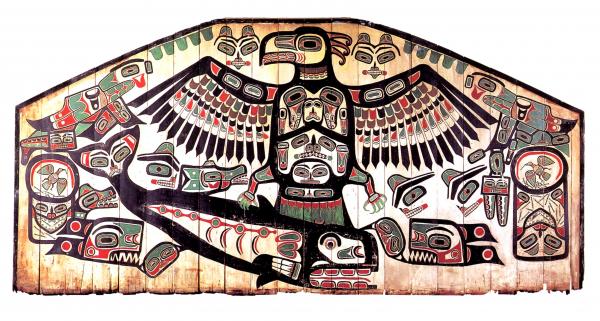Monumental heraldic screens of spruce panels painted with complex iconographic programs in natural pigments were created by Tlingit people of the northwest coast of Canada and Alaska; yet few such works stand testament today to this remarkable tradition. This exceptionally dramatic example divided public areas from the private quarters of a chief’s house, and would have been positioned on a platform.
Tlingit groups are divided into moieties, each composed of related families living in large communal houses. The Small Lake Tlingit were divided into the Eagle and Raven clans, and the screen’s depictions of chiefly totems were a clan’s “crest” or heraldic symbol, referring to the clan’s history and identity and attesting to the group’s prestige.
The striking scene is dominated by Thunderbird, the avatar of thunder and lightning, shown capturing an orca surrounded by sharks. With wings outstretched, Thunderbird bears the image of a totem spirit on his chest. Orca features his own totems as a pair of sharks on one upturned fin, the other surmounted by a wolf. Thunderbird and Orca are key emblems of the Wooshkitaan Eagle Clan, as are Shark and Wolf.
The screen is unusually well documented. Its design is based on a blanket acquired by Kaajiwadaja, a chief of the Wooshkitaan Eagle Clan. The work was commissioned in the last quarter of the 19th century by the Small Lake Tlingit spokesman at that time, Mike Moore, because an earlier screen had been accidentally destroyed by fire. The screen was painted by an artist named Rudolf of the opposing Raven Clan, suggesting reciprocal responsibilities of moieties. After its creation, the work was placed in the Eagle Clan’s Thunderbird House at Auke Village, in the province of Juneau, Alaska, and was used in numerous potlatches and ceremonial events as cosmology surrounding Thunderbird was recited, sung, and danced. A photograph shows the screen in use during the funeral of Mike Moore around 1900.
Potlatches were and still are extraordinary events staged by chiefs to bring communities together in elaborate performances of gift-giving and display. It is an opportunity for a chief to present the aesthetic integrity and virtuosity of his people, and a chance for him to reinforce genealogy while also conferring titles, ranks, and gifts. Attendees bring food, crafts, and works of art from their respective communities to contribute to the festivities’ panoply of visual and performing arts.
The screen was acquired by the Wallace family via a potlatch gift-giving feast and then passed down through the family until it was sold at auction in 1991; the work was acquired by the current owner at auction in 1995. Comparable screens are in the collections of the Denver and Seattle Art Museums, and other examples remain in Tlingit hands, including one also inspired by a textile.
For peoples of the Native Northwest Coast, livelihood, spiritual existence, and wellbeing reside in stories and powers attached to works rich in totemic motifs and related meanings. That Tlingit screens bear supernatural presence is reflected by a low circular opening in most, through which the chief could exit and enter, reborn from and otherwise intimately attached to his ancestors via the work’s complex symbolic allusions. It is likely that this screen once possessed such a portal, and served as a sacred threshold to another world.
During our 31st annual Collectors Committee Weekend (April 21–22), members of LACMA's Collectors Committee generously helped the museum acquire nine works of art spanning a breadth of eras and cultures. Check back tomorrow to learn about another acquisition.



